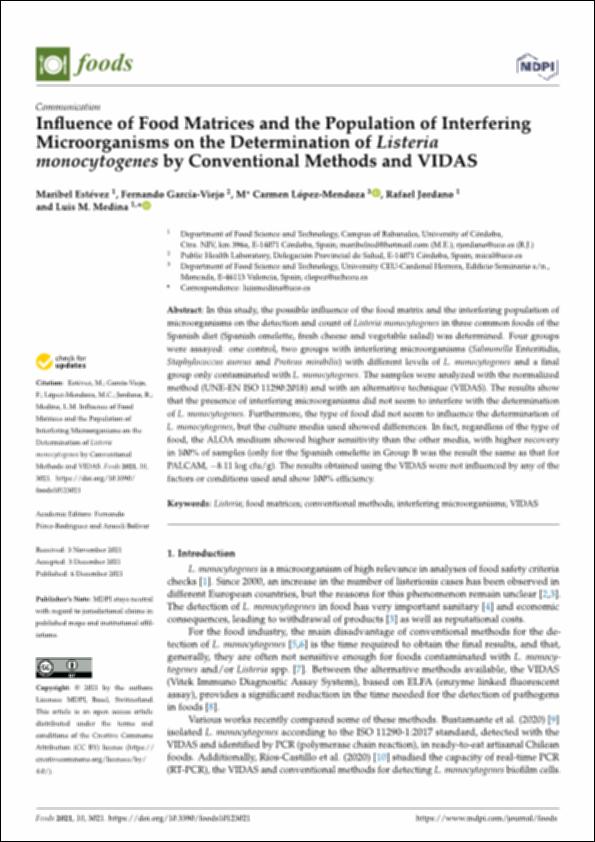Por favor, use este identificador para citar o enlazar este ítem:
http://hdl.handle.net/10637/13540Influence of food matrices and the population of interfering microorganisms on the determination of "Listeria monocytogenes" by conventional methods and VIDAS
| Título : | Influence of food matrices and the population of interfering microorganisms on the determination of "Listeria monocytogenes" by conventional methods and VIDAS |
| Autor : | Estévez, Maribel García Viejo, Fernando López Mendoza, María Carmen Jordano Salinas, Rafael Medina Canalejo, Luis Manuel |
| Materias: | Hazard analysis and critical control point (Food Safety System); Análisis de peligros y puntos críticos de control (Sistema de seguridad alimentaria); Alimentos - Control de calidad.; Listeria monocytogenes.; Listeriosis.; Intoxicación por alimentos.; Food poisoning.; Food - Quality. |
| Editorial : | MDPI |
| Citación : | Estévez, M., García-Viejo, F., López-Mendoza, M. C., Jordano, R. & Medina, L. M. (2021). Influence of food matrices and the population of interfering microorganisms on the determination of "Listeria monocytogenes" by conventional methods and VIDAS. Foods, vol. 10, i. 12 (06 dec.), art. 3021. DOI: https://doi.org/10.3390/foods10123021 |
| Resumen : | In this study, the possible influence of the food matrix and the interfering population of microorganisms on the detection and count of Listeria monocytogenes in three common foods of the Spanish diet (Spanish omelette, fresh cheese and vegetable salad) was determined. Four groups were assayed: one control, two groups with interfering microorganisms (Salmonella Enteritidis, Staphylococcus aureus and Proteus mirabilis) with different levels of L. monocytogenes and a final group only contaminated with L. monocytogenes. The samples were analyzed with the normalized method (UNE-EN ISO 11290:2018) and with an alternative technique (VIDAS). The results show that the presence of interfering microorganisms did not seem to interfere with the determination of L. monocytogenes. Furthermore, the type of food did not seem to influence the determination of L. monocytogenes, but the culture media used showed differences. In fact, regardless of the type of food, the ALOA medium showed higher sensitivity than the other media, with higher recovery in 100% of samples (only for the Spanish omelette in Group B was the result the same as that for PALCAM, 8.11 log cfu/g). The results obtained using the VIDAS were not influenced by any of the factors or conditions used and show 100% efficiency. |
| Descripción : | Este artículo se encuentra disponible en la siguiente URL: https://www.mdpi.com/2304-8158/10/12/3021 Este artículo pertenece al número especial "Listeria in Food: Prevalence and Control". |
| URI : | http://hdl.handle.net/10637/13540 |
| Derechos: | http://creativecommons.org/licenses/by/4.0/deed.es |
| ISSN : | 2304-8158 (Electrónico) |
| Fecha de publicación : | 6-dic-2021 |
| Centro : | Universidad Cardenal Herrera-CEU |
| Aparece en las colecciones: | Dpto. Producción y Sanidad Animal, Salud Pública Veterinaria y Ciencia y Tecnología de los Alimentos |
Los ítems de DSpace están protegidos por copyright, con todos los derechos reservados, a menos que se indique lo contrario.


